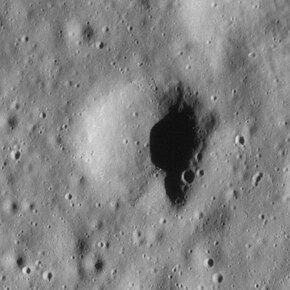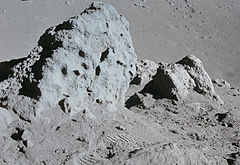Dune (crater)
 Apollo 15 panoramic camera image | |
| Coordinates | 26°02′N 3°40′E / 26.04°N 3.66°E |
|---|---|
| Diameter | 380 m[1] |
| Eponym | Astronaut-named feature |

Dune is a feature on Earth's Moon, a crater in the Hadley–Apennine region. Astronauts David Scott and James Irwin visited the south rim of it in 1971, on the Apollo 15 mission, during EVA 2. The south rim of Dune was designated Geology Station 4 of the mission.

Dune is located about 1.8 km east of Hadley Rille, less than 1 km south of the smaller Earthlight crater, and about 3 km south of the Apollo 15 landing site itself.
The crater was named by the astronauts after the 1965 novel by Frank Herbert,[2] and the name was formally adopted by the IAU in 1973.[1]

Samples
[edit]
The following samples were collected from Dune Crater (Station 4), as listed in Table 5-II of the Apollo 15 Preliminary Science Report.[3] Sample type, lithology, and description are from Table 5-IV of the same volume.
| Sample | Photo | Lithology | Description |
| 15470 to 15474 | - | soil | Collected with samples 15475 and 15476 |
| 15475 | - | basalt | Blocky, angular, medium-coarse-grained, porphyritic basalt with pale green prisms to 15 mm long in a slightly vuggy groundmass of plagioclase laths approximately 2 mm long and pale yellow-green pyroxene |
| 15476 | - | basalt | Slabby, subangular, porphyritic basalt with brown pyroxene phenocrysts to 15 mm long in a slightly vuggy groundmass of plagioclase, and brown and green mafic silicates |
| 15485 |  |
basalt | Blocky, angular basalt with brown pyroxene prisms to 7 mm long in a moderately vuggy groundmass of flow-aligned plagioclase 2 to 3 mm long, and green-brown mafic silicates |
| 15486 |  |
basalt | Blocky, angular, porphyritic basalt with brown pyroxene phenocrysts to 7 mm long in a slightly vuggy groundmass of plagioclase laths and pyroxene. Light greenish gray material coats the surface. |
| 15495 |  |
basalt | Blocky, subangular, vuggy basalt with dark-brown pyroxene prisms to 10 mm long in vugs. |
| 15498 |  |
breccia | A blocky, angular glass-coated breccia with approximately 10% leucocratic clasts bigger than 1 mm. Sizes are seriate and the rock contains 10 to 15% leucocratic clasts 0.5 to 1.0 mm. Dark, vesiclar glass in sharp contact with the breccia covers parts of four sides of the rock. The medium-gray matrix is coherent. |
| 15499 |   |
basalt | Blocky, angular, highly vesicular basalt. Vesicles appear to grade in size and abundance across the rock. One surface is coated by light yellowish-gray material grading into very dark brownish-gray coating at one edge. The rock is porphyritic with brown pyroxene prisms to 10 mm long in a groundmass of plagioclase laths and pyroxene. |
Samples 15470 to 15476 were collected near where the rover was parked to the south of the rim of Dune. Samples 15485, 15486, and 15499 were collected from the largest boulder in the photograph above. Sample 15498 was collected nearby.[3]
External links
[edit]- Apollo 15 Traverses, Lunar Photomap 41B4S4(25)
References
[edit]- ^ a b Dune, Gazetteer of Planetary Nomenclature, International Astronomical Union (IAU) Working Group for Planetary System Nomenclature (WGPSN)
- ^ Dreamer of Dune: The Biography of Frank Herbert, by Brian Herbert, 2004, page 244.
- ^ a b Apollo 15 Preliminary Science Report, NASA SP-289. Prepared by NASA Manned Spacecraft Center, 1972.
